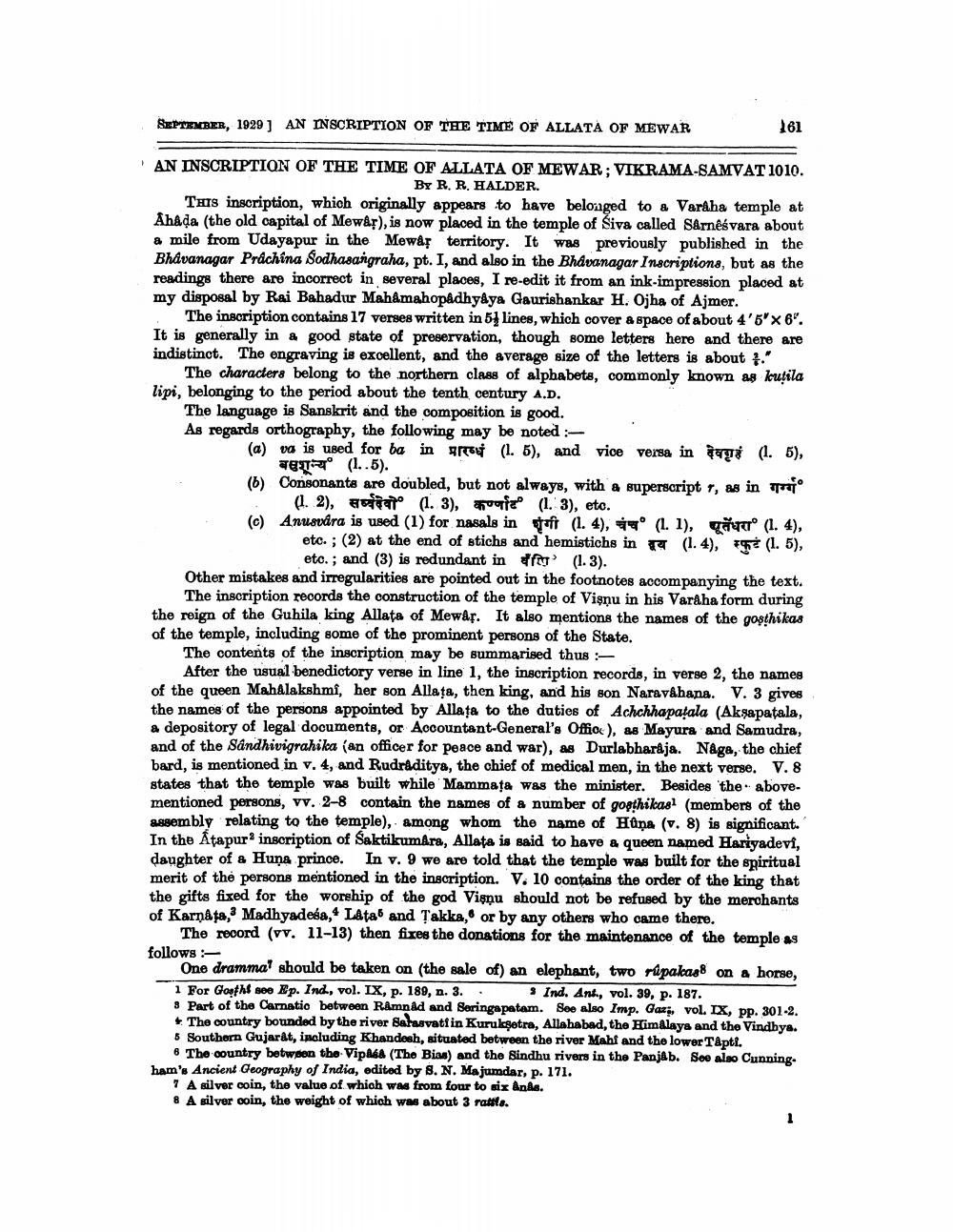________________
REPTEMBER, 1929] AN INSCRIPTION OF THE TIME OF ALLATA OF MEWAR
361
AN INSCRIPTION OF THE TIME OF ALLATA OF MEWAR; VIKRAMA-SAMVAT 1010.
BY R. R. HALDER. This inscription, which originally appears to have belonged to a Varaha temple at Ahada (the old capital of Mewar), is now placed in the temple of Siva called Sarnêsvara about a mile from Udayapur in the Mewar territory. It was previously published in the Bhavanagar Prachina Sodhasangraha, pt. I, and also in the Bhavanagar Inscriptions, but as the readings there are incorrect in several places, I re-edit it from an ink-impression placed at my disposal by Rai Bahadur Mahamahopadhyâya Gaurishankar H. Ojha of Ajmer.
The inscription contains 17 verses written in 54 lines, which cover a space of about 4'5' 6". It is generally in a good state of preservation, though some letters here and there are indistinct. The engraving is excellent, and the average size of the letters is about 1."
The characters belong to the northern class of alphabets, commonly known as kutila lipi, belonging to the period about the tenth century A.D.
The language is Sanskrit and the composition is good. As regards orthography, the following may be noted -
(a) va is used for ba in error (1. 5), and vice versa in g* (.5),
TET (1..5). (6) Consonants are doubled, but not always, with a superscript 7, as in jo
(1.2), notat (1. 3), oft (1. 3), eto. (c) Anusvára is used (1) for nasals in (1. 4), 14° (1. l), garo (1.4),
etc. ; (2) at the end of stichs and hemistichs in (1.4), (1. 5),
etc.; and (3) is redundant in dre' (1.3). Other mistakes and irregularities are pointed out in the footnotes accompanying the text.
The inscription records the construction of the temple of Vişnu in his Varáha form during the reign of the Guhila king Allata of Mewar. It also mentions the names of the gosthikas of the temple, including some of the prominent persons of the State.
The contents of the inscription may be summarised thus
After the usual benedictory verse in line 1, the inscription records, in verse 2, the names of the queen Mahalakshmi, her son Allața, then king, and his son Naravdhana. V. 3 gives the names of the persons appointed by Allața to the duties of Achchhapatala (Akşapatala, a depository of legal documents, or Accountant-General's Offioc), 88 Mayura and Samudra, and of the Sandhivigrahika (an officer for peace and war), as Durlabharaja. Någa, the chief bard, is mentioned in v. 4, and Rudraditya, the chief of medical men, in the next verse. V. 8 states that the temple was built while Mammața was the minister. Besides the abovementioned persons, vv. 2-8 contain the names of a number of gopthikasl (members of the assembly relating to the temple), among whom the name of Hûna (v. 8) is significant In the Átapur inscription of SaktikumAra, Allata is said to have a queen named Hariyadevi, daughter of a Huna prince. In v. 9 we are told that the temple was built for the spiritual merit of the persons mentioned in the inscription. V. 10 contains the order of the king that the gifts fixed for the worship of the god Vişņu should not be refused by the merchants of Karnata 3 Madhyadesa, Lata and Takka, or by any others who came there.
The record (vv. 11-13) then fixes the donations for the maintenance of the temple follows
One drammat should be taken on the sale of) an elephant, two rúpakas on a horse, 1 For Gosthi see Ep. Ind., vol. IX, p. 189, n. 3.. Ind. Ant., vol. 39, p. 187. 8 Part of the Carnatio between Ramnad and Seringapatam. See also Imp. Gars. vol. IX, pp. 301-2.
The country bounded by the river Salasvatiin Kuruksetra, Allahabad, the Himalaya and the Vindhya. 5 Southern Gujarat, including Khandesh, situated between the river Mahi and the lower Tapti.
6 The country between the Vipka (The Bias) and the Sindhu rivers in the Panjab. See also Cunning. ham's Ancient Geography of India, edited by S. N. Majumdar, p. 171.
7 A silver coin, the value of which was from four to six Anda. 8 A silver coin, the weight of which was about 3 rattle.




